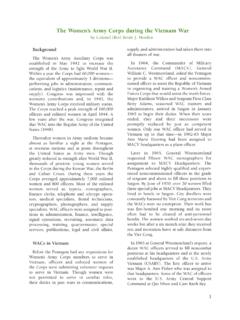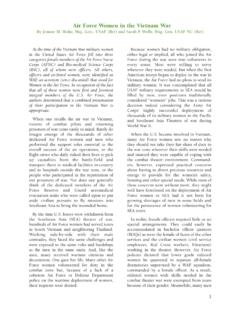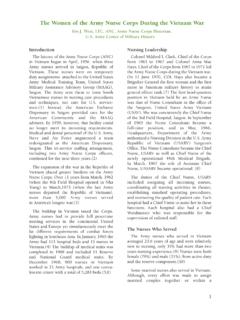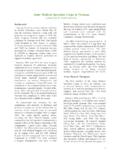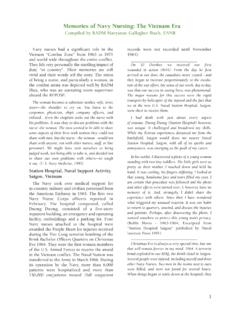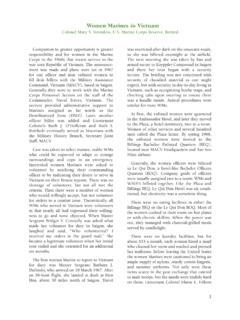Transcription of Moving a Vision: The Vietnam Women’s Memorial
1 BACKGROUNDThe Vietnam women 's Memorial was dedicated on the National Mall just yards fromthe Vietnam Veterans Memorial , The Wall,onNovember 11, 1993, in Washington, Onemay think that the approval, placement, andfinancing of a statue for such a just causewould be a relatively simple process after all,this was the first Memorial on the Mall of ournation's capital to honor the military service ofwomen. To the contrary, the process was longand arduous and included two separate piecesof Congressional legislation and approval ofthree federal commissions. The dedication ofthe Vietnam women 's Memorial (VWM) represented the culmination of a 10-year struggle by thousands of volunteers who over-came controversy, rejection, and challenge bythose who thought that a women 's memorialwas not needed. This case study is about thepassion, the process, and the politics of turninga vision into reality and how one former armynurse made a profound difference in women 'shistory ( Vietnam women 's Memorial Project, 1993).
2 Moving A VISIONWhen this monument is finished, it will befor all time a testament to a group of Americanwomen who made an extraordinary sacrifice atan extraordinary time in our nations history:the women who went to war in am grateful for the unstinting help from so many whogave their time, expertise, and talents to make theVietnam women s Memorial a reality. Special thanks toColonel A. Jane Carson, USA, Ret. (Army Nurse Corps),and Diana Hellinger, whose wisdom, inspiration, andencouragement helped make this case study You served. You And yet your serviceand your sacrifice have been mostly invisible for all theseintervening years. When you finished what you had to do,you came quietly home. You stepped back into the back-ground from which you had modestly come. You meltedaway into a society which, for too long now, has ignoredthe vital and endless work that falls to women and is not appreciated as it should be.
3 [Powell, 1993]General Colin Powell's words rang with passion and purpose on the day of ground-breaking for the Vietnam women 's Memorial ,July 29, 1993. In listening to his every word onthat historic day, one couldn't help but driftand digress to many years before. Thousands ofwomen left the comforts of America to findthemselves in the midst of guerilla volunteered, they served in helmetsand flak jackets, spending long hours easingthe pain and suffering of wounded July 1, 1980, President Jimmy Cartersigned legislation granting the Vietnam Veterans Memorial Fund (WMF) authorizationto construct a Memorial on a site of two acresin Constitution Gardens near the Lincoln Memorial in Washington, The legislationread that the Memorial would honor men andwomen of the armed forces of the United Stateswho served in Vietnam . Two years after authorization was received, the design andplans were approved and construction wasunder way.
4 The Vietnam Veterans Memorial ,designed by Maya Lin and commonly referredto as the Wall, was formally dedicated onNovember 13, as the Vietnam war had divided ournation, the veterans themselves were dividedon the design of their Memorial . Some arguedthat the V-shaped wall was inadequate anddemanded something more heroic. Some calledit a big black scar, a black gash of shame, a holein the ground. A compromise was struck to settle the dispute. Former Secretary of theInterior James Watt had refused to authorizeconstruction of the Wall unless a statue of anAmerican soldier was added to it. The directorsof the VVMF agreed to commission the highest-ranking sculptor in the design competition, Frederick Hart, of Washington, He would design a bronze sculpture ofthree infantrymen to accommodate concernthat the Wall lacked specific symbols of the Moving a vision : The Vietnam women s Memorial Diane Carlson Evansveterans and their patriotism.
5 Mr. Hartdescribed his design follows:The portrayal of the figures is consistent with wear the uniform and carry the equipment of war;they are young. The contrast between the innocence oftheir youth and weapons of war underscores the poignancy of their sacrifice. There is about them thephysical contact and sense of unit that bespeaks thebonds of love and sacrifice that is the nature of men atwar. And yet they are each alone. Their strength and theirvulnerability are both evident dent. Their true heroism lies in these bonds of loyalty in the face of theiraloneness and their vulnerability. [ Vietnam VeteransMemorial Fund, 1982]In 1983 a photograph of a bronze statue por-traying three military men appeared in national newspapers, raising painful personalawareness that our country did not and mightnot ever know the women who served along-side those depicted.
6 Consistent with history. These words crystallized for me the need to change that consistency, that image. In 1983 when I saw thedesign commissioned by Mr. Hart, I was movedby what I did not see. His account that the portrayal of figures was consistent with history reflected the belief that only men serveand therefore are portrayed. The names of eightwomen nurses who died in Vietnam are etchedon the granite wall. The Wall, in its minimalistic concept and simplicity, was complete as Maya Lin had described it. Thenames of men and women who died inVietnam were etched together in granite foreternity. With the dedication, Americans beganto learn about the lives and losses of the maleand female soldiers. They were able to begintheir healing journey. I was struck by a personal belief that the addition of the Hartstatue honoring the living implored anotherpoint of view, and another healing element.
7 Although people would see men inbronze, a whole and true portrait of the womenwho served during the Vietnam War, depictingtheir professionalism, dedication, service, andsacrifice, had yet to be seen their stories yetto be heard. women , too, needed a healingplace and a healing process. Historically, women who have served humanity duringAmerica's struggles and wars are not includedin the artistic portrayals. They slip into historyunrecognized and forgotten, compounding themyth that either they did not serve or theirservice was not noteworthy. They, too, had dis-appeared off the landscape of the Vietnam many thought that the addition ofthe statue portraying three servicemen completed the Vietnam Veterans Memorial , it isparadoxical that it rendered an piece of history remained missing. By allpublic accounts, the profound legacy ofwomen's service in Vietnam was sealed, closedfrom view, and dispensable.
8 The time hadcome. The norm of leaving women out of thehistorical account of war had to that people would support amemorial honoring women if given the information and the opportunity, I gave myfirst speech in 1983 at a Lions Club. My anxiety grew as I looked out on the room andthought about the public, which had once beenhostile and unappreciative. Reexperiencing myfeelings when I stepped off the plane in theUnited States on my return from Vietnam andwas greeted by angry war protesters, my kneeswent limp and I started to shake. I was reluc-tant to speak experientially, to open myself upto strangers. I talked about the other womenand said that more often than not it was anAmerican nurse who a soldier looked to duringthe last moments of his life. I talked about theVietnam Veterans Memorial how beautifuland fitting it is, but that women needed to behonored and remembered as well.
9 There weremany questions about my own service. Thespeech ended with a standing ovation. I wasstunned and realized I would have to overcomefear and personal anxieties and share some ofmy own stories. I remembered what EleanorRoosevelt said: You gain strength, courage,and confidence by every experience in whichyou really stop to look fear in the Youmust do the thing you think you cannot do. Perhaps it was fate that year when I attendedmy first veterans reunion in my home state ofMinnesota. It included an exhibition of war artby veterans. No images of women were depicted. There I saw a work of sculptorRodger Brodin entitled The Squad, a realisticdepiction in bronze of 13 grunts on patrol. Iwas instantly taken back to Vietnam . I felt compelled to call and ask Rodger whether hehad ever thought of sculpting a woman met, and over the course of 5 monthsRodger listened to my stories of the womenwho had served and those of the war: the deaths, weariness, frustration, and seeingyoung American men and Vietnamese mutilated.
10 Using a 21 year-old model, he created a 33 inch bronze composite of a military nurse. She was to become the galvanizing force and symbol affectionatelynamed the Lady by former GIs. To Rodger she was The never been involved in politicalaction, raised funds, or spoken to the media orthe public, and with a suspicious view of government and the press because of my personal experience in the Vietnam War, I nowhad to find the courage to work toward work did not frighten me. Failure toachieve rightful honor for women did. I had anunsettling feeling of powerlessness reminiscent of wading into uncharted territory not unlike stepping off a helicopterin Vietnam , entering a field hospital, and asking, Where do I start? Anxiety was justified. Little did I know thatrealizing this vision would require a full-time,10 year campaign convincing governmentagencies, Congress, journalists, and the engaged in vilifying our service andundermined our intent to honor women .
